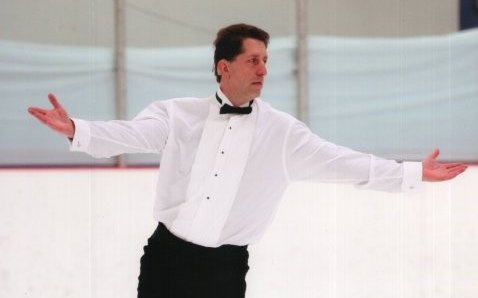By Aviva M. Cantor
In a sport which relies heavily on musicality and artistic impression, one may not expect to find dedicated competitive figure skaters who can barely hear the music. Despite the great challenge of competing with severe hearing loss, Lynn Stone (65, adult bronze) and Dennis Glorioso (64, adult gold) have defied the odds.

"I initially experienced unilateral hearing loss in my left ear at the age of 43,” Stone said. “The loss subsequently progressed to both ears. The degree of loss is substantial; without hearing aids I am unable to hear many — if not most — normal sounds.”
“I was first diagnosed with hearing loss at age 20,” Glorioso, a 17-time U.S. Adult Championships competitor, said. “It progressively worsened over the years. By the time I was 35, I was profoundly deaf in both ears. Without my bilateral cochlear implants, I’m legally deaf.”
Though both tried skating as kids, Stone and Glorioso didn’t become dedicated competitors until adulthood, after their hearing loss had worsened.
“We didn’t have rinks in New Orleans where I grew up,” Stone said. “I've skated over the years when my schedule allowed, and when I took my young daughter to lessons. All of my military assignment locations had rinks. I started taking my own lessons somewhere around 1998.”
Glorioso remembers having a difficult time getting started.

“When my daughter was 8, I got her involved in skating for a couple of years,” he said. “During that time, I tried to skate but found that the hearing loss combined with powerful hearing aids made me dizzy on the ice. I didn’t attempt to skate again until I had my first cochlear implant in January 2000. I was off the ice until I was 44; then, I found I was not getting severely dizzy anymore. I was hooked.”
Skating with hearing loss provides a unique set of challenges, particularly when it comes to hearing music for a competition or test. As ice dance requires a skater to stay on time with a specific beat, it can be the most challenging discipline for hearing-impaired skaters. Both Stone and Glorioso note that they rely mostly on internal rhythm and depend on their trustworthy partners to assist with timing.
“My coaches are considerate and diligent in making sure my music is loud enough for me to hear on the ice,” Stone said.
“I always have my music played louder and usually get someone to cue me for competitions just to be sure I'm on time,” Glorioso said. “I have found good ways to secure my hearing devices. They’ve fallen off very rarely. Hearing aids or processors are more resilient than you might think. I use wig tape for competitions and usually a skull cap for practice to keep my devices secure on my head. I have never broken any bones skating. I guess I’m resilient, too!”
With resiliency and perseverance, Stone and Glorioso have shown great longevity in the sport, which they’ve been enjoying as competitors for more than two decades. Glorioso wishes that more skaters would embrace the challenge, noting that “many hearing-impaired people tend to be solitary. Figure skating is a fulfilling and therapeutic activity for the hearing impaired or deaf. Don’t be afraid to lace up!”
“While there are constraints we all live by, the only limits to what we can do are those placed on us by ourselves,” Stone said.


